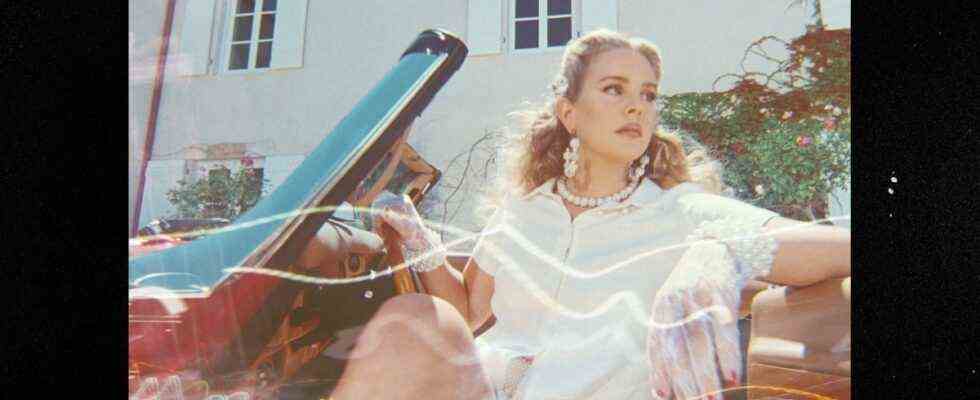If you were Lana Del Rey yourself, you would have to keep asking yourself these wretched questions with every new song, album or video. These basic things: what can actually come next? Isn’t the concept slowly exhausted with all the Hollywood Hills and melancholy fuss? Maybe also: Is there any detail there for which the Instagram people will berate you as a racist or sexism apologist? Oh, it must be unbearable.
In the first moment, this is one of the most pleasant accompanying feelings when this singer and songwriter publishes a work again, like now, for the second time in 2021: the realization that we don’t have to bother with all these considerations because the artist wants it us does. In the second moment you even notice that Lana Del Rey, the often vilified and underestimated, has indeed found some fascinatingly interesting answers to the questions with her new, eighth album since 2010, “Blue Banisters”. And as much as reason tells you that it’s enough with the black and white film diva clinging, the heavily sweet breath and the meaningful American analogies – in the end you have to recommend this record again. Maybe not urgently, but still.
The themes for a four-minute song: language, youth, intoxication, love, freedom and motorized locomotion
“Banister”, the word is not very well known, means railing, for example on a veranda. The video for the title song literally shows in one scene Lana Del Rey and a cheerful group of friends painting this railing, not green or yellow, but blue. Perhaps it will be what the people are unfavorably interpreting for her this time: blue as the color of the right-wing conservative blue-eye glorification or the cornflowers that politicians from the AfD and FPÖ like to infect.
Such symbol panels are likely to be the last thing the 36-year-old native of New York thought about here. If the blue picket fence on “Blue Banisters” stands for anything, then at most for the great dilemma question of how any kind of concise life plan can be reconciled with the inner storm and madness that the creative self experiences. Whether a comparison between the worlds is still possible at all, a compromise between the unleashed instincts of modern man and the traditional social forms that we still follow in the absence of an alternative. “I get wild and fucking crazy, like the color blue”, Lana Del Rey sings in “Nectar Of The Gods”, and although the piece is only a good four minutes long, everything comes up here, youth, intoxication, love, Freedom, motorized locomotion, and of course somehow: California. It just doesn’t seem to be about death, but one can be mistaken about that.
In “Arcadia” she describes her body as the image of an American road map
Del Rey became known about ten years ago as a slightly shady, melancholy update of a Beverly Hills lady, with all the inappropriateness built in. She sang about blue jeans and video games, sounding nostalgic to some, cleverly ironic to others, like a cartoon to others, like the cartoon woman from “Roger Rabbit”. She caught criticism for embodying a submissive, backward doll image. Among other things, he responded with the fantastic albums “Norman Fucking Rockwell!” and “Chemtrails Over The Country Club”, on which she added gestures of self-empowerment to her role-play that was far removed from the language of the feminist academy.
But what is she doing now? For example, she sings about her body, describing it in “Arcadia” as the image of an American road map: the breasts are the Sierra Madre, the hips the Interstate Highway, the buttocks the city of San Gabriel. What sounds like a man’s joke on paper turns into a brilliant female omnipotence fantasy, a kind of musical selfie that shows every pore, with Lana Del Rey – as a grave piano hymn including an orchestra wafting through the picture. A fitting replacement for the pictures she deleted in mid-September when she closed her social media accounts overnight.
The passage in the song “Text Book”, in which she succinctly describes the visit to a “Black Lives Matter” demo, was a bit of anger. As painful as it may be with such burning topics, this is exactly what so much of Lana Del Rey’s art revolves around: the suffering from the insignificance of social rituals, which in the end can also include a protest march. The search for truth in the dazzling realm of introversion. And about the attempts to use the knowledge gained there to build working relationships after all.
Even musically, the structures on “Blue Banisters” sometimes begin to dissolve. Every now and then the rhythm gets lost between the piano and the background noise, the background singers in the great “Black Bathing Suit” fall wonderfully out of their role. Then in “Dealer,” a duet with Miles Kane, Lana Del Rey freaks out in a way that has never been heard before. And the Blue Velvet cocktail plush bar roars in such a way that the guests’ ears will probably still be hissing for days.
From a consumer perspective, “Blue Banisters” may not rank quite as high as the previous two masterpieces. The album becomes a bit uniform in the second half, some leftovers from old sessions have been added, it is a bit dragging on. In retrospect, it will probably be considered a hybrid transitional work at some point, but to say that one would have to know what Lana Del Rey wants to add to this. And the question really doesn’t need to be answered today.

